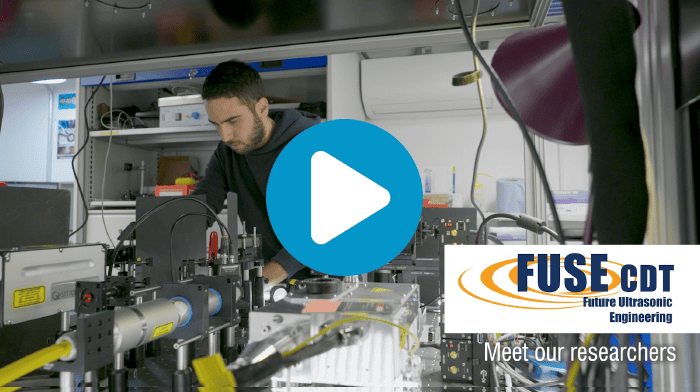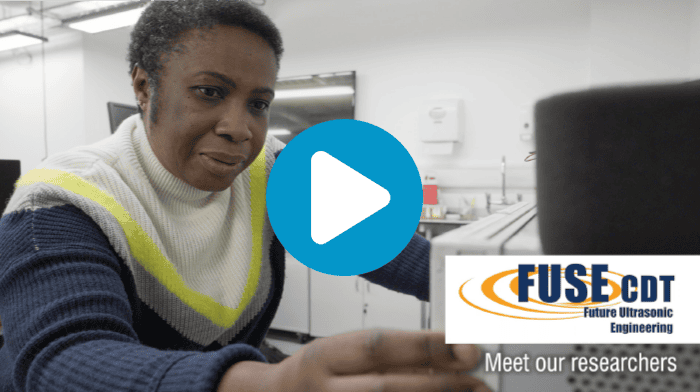Cohort 2 (2020)
Sonar Systems Use Pressure Wave to Detect an Object in Maritime Domain
Ultrasonic technologies are used to detect acoustic signals such as those in the maritime domain (sonar systems), during NDT/E inspections or in medical diagnostic procedures contain various electronics building blocks. For instance, the acoustic sensor, which can be often based on piezoelectric or capacitive micromachined ultrasonic transducer (PMUT or CMUT) technologies, converts the detected pressure wave into an electrical signal before electronics amplify, filter, and digitise this signal, which is then processed and an image of the object under detection is projected to the operator. The demand on the next generation of ultrasonic sensor systems increasingly requires them to be contained within a smaller footprint and possess lower power demands while exhibiting enhanced detection capability. The electronics used in these systems are typically based on printed circuit board (PCB) technologies which can have a large footprint and high-power demands which may require additional infrastructure to prevent overheating.
My project will investigate the development of ultralow-power millimetre-sized integrated electronics, referred to as system-on-chip (SoC), for incorporation into compact acoustic sensors for use in the maritime domain, where payload and power limitations are critical. Integration of SoC with CMOS (complementary metal oxide semiconductor) technology will allow the implementation of a wide range of acoustic sensors for a spectrum of sensing and imaging applications where high fill factors, good signal to noise ratio, small size and low power consumption are fundamental to operational success. My project will explore the miniaturisation of low power electronics which are compatible for CMUT-based sensors deployed in the maritime domain.
Its provisional objectives are:
• Form a fundamental understanding of design and fabrication techniques used in the development of milli-metre sized electronics (using integrated CMOS technology).
• Design different circuit blocks e.g. the power management unit, analogue front end consists of low noise amplifier (LNA), low pass filter, digitization backend (e.g. ADC) and circuitry techniques for ripple cancellation.
• CMOS-Acoustic device integration techniques e.g. monolithically or flip-chip technology
• Explore the main trade-offs and main contributors to circuit; power consumption, noise generation, operational bandwidth and dynamic range, and prototype candidate solutions.
• Form a fundamental understanding of sonar, underwater detection and the maritime environment.
• Demonstrate candidate sonar transducers in a representative environment. For instance, at a Thales UK facility.
My project will be conducted in the Microelectronics Lab at the Centre for Medical and Industrial Ultrasonic (CMIU). It will give full knowledge of ultrasonics, electronics design, PCB design, IC integration circuit, control system, programming that will build ultrasonic SOC system.
Primary Supervisor (University of Glasgow): Prof. Hadi Heidari
Secondary Supervisor (University of Strathclyde): Prof. James Windmill
Project External Partner: Thales
Acoustic Metamaterials for Ultrasonic Applications
The aim of this PhD project is to investigate using acoustic metamaterials to manipulate ultrasound. This will focus on developing metamaterials by creating arrays of resonators (for example Helmholtz resonators or membranes), where tuning of the geometrical properties of individual resonators allows for attenuation and, through good design, waveguiding and steering. These acoustic metamaterials have a broad range of applications in both scientific applications and industrial settings. In the project, the student will explore designs of structured material with local, sub-wavelength resonators, for ultrasonic applications. It will entail 3D printing, finite-element modelling, and experimental testing and characterization. The student will learn, develop, and apply the theories of metamaterial behaviour to create a new generation of practical ultrasonic sensors and materials.
Topics that are of interest for collaboration are: acoustic metamaterials, 3D printing, acoustic modelling, COMSOL, acoustic experimental testing. Please feel free to contact me at: a.gardiner.1@research.gla.ac.uk
Primary Supervisor (University of Glasgow): Dr. Andrew Feeney
Secondary Supervisor (University of Strathclyde): Prof. James Windmill
Automated Laser Ultrasonics for Metal 3D Printing Inspection
Additive Manufacturing (AM) is an exponentially growing manufacturing technique which offers numerous advantages over alternative methods in terms of design flexibility, waste and lead-time reduction. More specifically, the Wire Arc AM (WAAM) technology enables the production of metal structures both small and large, while reducing the manufacturing duration and cost by approximately 50%. Some of the alternative, subtractive methods include forging and extensive machining which can result in higher costs and material waste.
The aim of my PhD project is the automation of remote ultrasonic inspection of components using robotic means coupled with laser ultrasonics to perform in-process Non-Destructive Evaluation during the WAAM cycle. Non-Destructive evaluation (NDE) is a widely used method of quality assurance and structural integrity in the manufacturing industry. Using laser ultrasonics rather than transducer-based ultrasound enables a non-contact inspection which is ideal for in-process inspection in the manufacturing industry, since the manufacturing process radiates high temperatures. Laser ultrasound can also cope with the complexity of the components among other advantages.
Primary Supervisor (University of Strathclyde): Dr. Theodosia Stratoudaki
Secondary Supervisor (University of Glasgow): Prof. Sandy Cochran
Project External Partner: WAAM3D
Clarity for the Cavity: a Framework for Acoustic Cavitation Measurement and Reporting
Cavitation (ultrasonically driven bubble activity) has a variety of applications in the medical and industrial sectors. However, there is currently no framework for the measurement and reporting of cavitation which means that the scientific literature is inconsistent, and it is difficult to compare studies from different groups. Current issues include metrics, such as the mechanical index, that are being used beyond their limitations and a lack of a proper classification system means that cavitation is often categorised as either stable or inertial with little scientific reasoning.
The aim of my project is to develop a scientifically grounded framework that will tackle these issues and will allow for meaningful comparison between similar studies over a range of medical and industrial applications. To do this, I will study many types of cavitation in experiments that are representative of the applications. High-speed imaging with parallel acoustic monitoring will help determine a fundamental understanding of the acoustic cavitation signal, which will allow for the critical analysis of current practices and propose new ones.
In partnership with Precision Acoustics Ltd, I hope to share my findings with the British Standards Institute (BSI) committee on ultrasonics and contribute to international standards that will ensure more consistency in cavitation research.
Primary Supervisor (University of Glasgow): Dr. Paul Prentice
Secondary Supervisor (University of Strathclyde): Prof. Tony Gachagan
Project External Partner: Precision Acoustics
An Enhanced Biopsy Needle for Endobronchial and other Biopsy Procedures
As a current PHD student in the Future Ultrasonic Engineering (FUSE) CDT, my research theme in collaboration with the NHS is to explore a re-engineered transbronchial biopsy needle to improve sample tissue yield.
In medicine, especially in cancer medicine, biopsy procedures are of critical importance as they allow tissue sampling by insertion of a hollow needle for use in various medical tests. One type of needle biopsy currently in use is endobronchial ultrasound guided transbronchial needle aspiration (EBUS-TBNA) which, is used to sample lymph node tissue to stage cancers and diagnose granulomatous diseases. During the EBUS-TBNA procedure, a tubular medical imaging tool (a bronchoscope) is inserted through the patient’s mouth into the bronchial tree. Once the right location in the bronchial tree is found using the attached ultrasound system, a needle pierces through the bronchial wall into the lymph node to collect the tissue sample. Several medical institutions around the world, have found that the procedure suffers from a sub-diagnostic ability as the devices currently use push the tissue away rather than allowing it to enter the needle, due to the needle tip shape. Because of that, the diagnostic yield is characterized by the quality if the collected tissue sample, is estimated to be 61%. A failed diagnostic procedure slows down treatment and causes additional strain on patients and hospital infrastructure.
The aim of my PHD project therefore will be to design a better needle. This will be achieved by understanding the properties of the tissue and its interaction with the needle. To achieve the tasks, several areas will be looked at:
- The needle types, tissue type and insertion speed.
- Through examination, what happens at the tip of the needle during the puncture of a membrane involving cadaver and critical specimen will be explore.
- A model describing the interaction between the different aspects of a needle-tissue interaction. This model is particularly important as it enable the detailed encoding of experiment equipment, condition, design and results and can therefore be used as the blueprint for a database of experimental needle interaction with human tissue.
I am excited to move forward in this research and I hope my findings will contribute to better medical practice at an international level.
Primary Supervisor (University of Glasgow): Prof. Sandy Cochran
Secondary Supervisor (University of Strathclyde): Dr. Emma Henderson
Project External Partner: NHS Greater Glasgow & Clyde
Surgery and Therapy with Power Ultrasonics Devices made with Lead-Free Materials
In ultrasonic devices, the piezoelectric material is the principal source of ultrasound. In ultrasonic devices used in therapeutic and surgical applications, the most commonly used piezoelectric material is lead zirconate titanate (PZT), a lead-based piezoelectric ceramic. However, due to the adverse effect of lead on human health and the environment, as well as the health and safety legislation relating to its use in electronic and medical devices, there is an increasing demand for lead-free piezoelectric materials.
The performance of power ultrasonic devices is reliant on the elastic, piezoelectric and dielectric (EPD) constants of the piezoelectric material adopted in the design process. Also, the EPD matrices, populated by these constants, are vital inputs for finite element modelling used in the design of devices. Hence, it is essential to obtain the full elastic, piezoelectric and dielectric constants of new lead-free piezoelectric materials in order to evaluate their properties for use in power ultrasonic devices for therapy and surgery.
The overall aim of my PhD project, a collaboration between FUSE CDT and Meggitt A/S, is to propose novel power ultrasonic device designs by combining finite element analysis with the full characterisation of newly developed lead-free piezoelectric materials. To achieve this aim, a method which combines conventional characterisation techniques with a finite element model optimisation algorithm will be used to obtain the EPD constants for a range of lead-free materials. The research will investigate how these properties of the lead-free materials can be optimally employed in power ultrasonic devices through proposing novel transducer configurations.
Primary Supervisor (University of Glasgow): Prof. Margaret Lucas
Secondary Supervisor (University of Strathclyde): Dr. Richard O’Leary
Project External Partner: CTS Ferroperm Piezoceramics
Towards autonomous surgery: Investigation of Autonomous Multiple Manipulator Ultrasound Scanning
During surgery with ultrasound imaging the ultrasound probe can be placed in a less than ideal position leading to suboptimal images for the surgeon to use. Usually in minimally invasive surgery the imaging system is controlled by the least experienced member of the operating team leading to more difficult images for the surgeon to use as guidance. It is often difficult to find a suitable acoustic window to image while operating or treating noninvasively using ultrasound, and this challenge is compounded by the need to provide good acoustic coupling between transducers and the body. My project looks towards a system than can autonomously scan, collect, and display clear real-time ultrasound images of the region of interest.
My initial research is into creating a simulation of the robot manipulator and focusing on the workflow and key parameters needed to successfully simulate an ultrasound probe. This would include the limitations of robotic manipulators movement and force applied to the skin. The main aim of this project is to support surgery with real time ultrasound imaging.
Primary Supervisor (University of Glasgow): Dr. Kevin Worrall
Secondary Supervisor (University of Strathclyde): Prof. Gordon Dobie
Project External Partner: Verasonics

